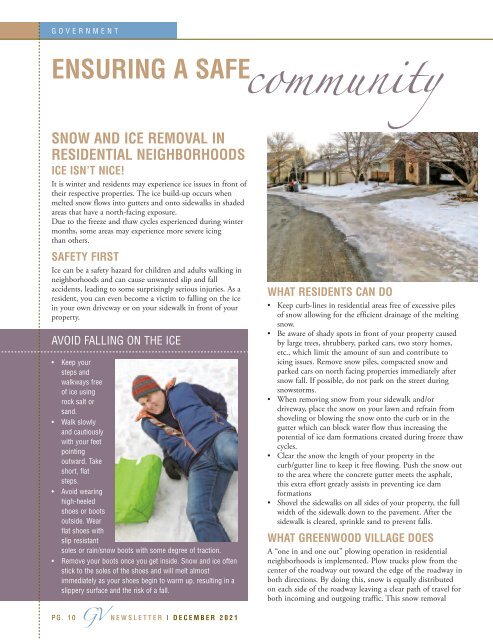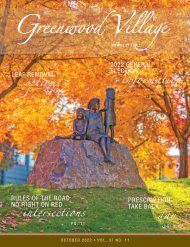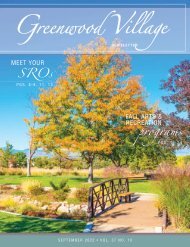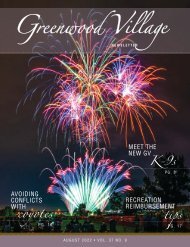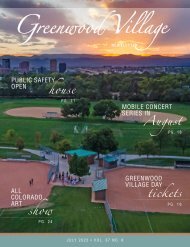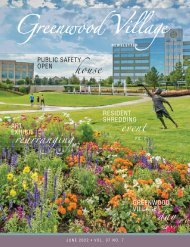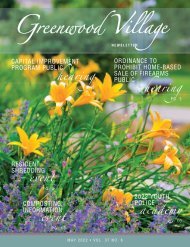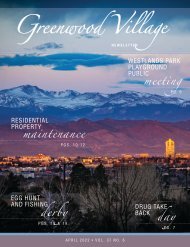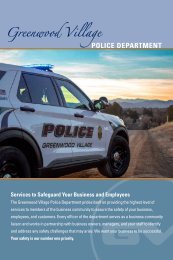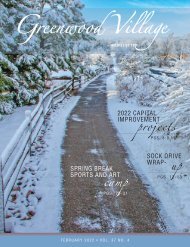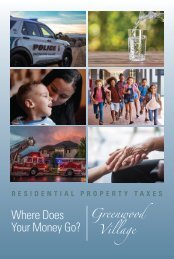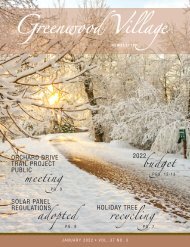GV Newsletter 12-2021 web
December Newsletter
December Newsletter
- No tags were found...
You also want an ePaper? Increase the reach of your titles
YUMPU automatically turns print PDFs into web optimized ePapers that Google loves.
GOVERNMENT<br />
ENSURING A SAFE<br />
community<br />
SNOW AND ICE REMOVAL IN<br />
RESIDENTIAL NEIGHBORHOODS<br />
ICE ISN’T NICE!<br />
It is winter and residents may experience ice issues in front of<br />
their respective properties. The ice build-up occurs when<br />
melted snow flows into gutters and onto sidewalks in shaded<br />
areas that have a north-facing exposure.<br />
Due to the freeze and thaw cycles experienced during winter<br />
months, some areas may experience more severe icing<br />
than others.<br />
SAFETY FIRST<br />
Ice can be a safety hazard for children and adults walking in<br />
neighborhoods and can cause unwanted slip and fall<br />
accidents, leading to some surprisingly serious injuries. As a<br />
resident, you can even become a victim to falling on the ice<br />
in your own driveway or on your sidewalk in front of your<br />
property.<br />
AVOID FALLING ON THE ICE<br />
• Keep your<br />
steps and<br />
walkways free<br />
of ice using<br />
rock salt or<br />
sand.<br />
• Walk slowly<br />
and cautiously<br />
with your feet<br />
pointing<br />
outward. Take<br />
short, flat<br />
steps.<br />
• Avoid wearing<br />
high-heeled<br />
shoes or boots<br />
outside. Wear<br />
flat shoes with<br />
slip resistant<br />
soles or rain/snow boots with some degree of traction.<br />
• Remove your boots once you get inside. Snow and ice often<br />
stick to the soles of the shoes and will melt almost<br />
immediately as your shoes begin to warm up, resulting in a<br />
slippery surface and the risk of a fall.<br />
WHAT RESIDENTS CAN DO<br />
• Keep curb-lines in residential areas free of excessive piles<br />
of snow allowing for the efficient drainage of the melting<br />
snow.<br />
• Be aware of shady spots in front of your property caused<br />
by large trees, shrubbery, parked cars, two story homes,<br />
etc., which limit the amount of sun and contribute to<br />
icing issues. Remove snow piles, compacted snow and<br />
parked cars on north facing properties immediately after<br />
snow fall. If possible, do not park on the street during<br />
snowstorms.<br />
• When removing snow from your sidewalk and/or<br />
driveway, place the snow on your lawn and refrain from<br />
shoveling or blowing the snow onto the curb or in the<br />
gutter which can block water flow thus increasing the<br />
potential of ice dam formations created during freeze thaw<br />
cycles.<br />
• Clear the snow the length of your property in the<br />
curb/gutter line to keep it free flowing. Push the snow out<br />
to the area where the concrete gutter meets the asphalt,<br />
this extra effort greatly assists in preventing ice dam<br />
formations<br />
• Shovel the sidewalks on all sides of your property, the full<br />
width of the sidewalk down to the pavement. After the<br />
sidewalk is cleared, sprinkle sand to prevent falls.<br />
WHAT GREENWOOD VILLAGE DOES<br />
A “one in and one out” plowing operation in residential<br />
neighborhoods is implemented. Plow trucks plow from the<br />
center of the roadway out toward the edge of the roadway in<br />
both directions. By doing this, snow is equally distributed<br />
on each side of the roadway leaving a clear path of travel for<br />
both incoming and outgoing traffic. This snow removal<br />
PG. 10 <strong>GV</strong> NEWSLETTER | DECEMBER <strong>2021</strong>


